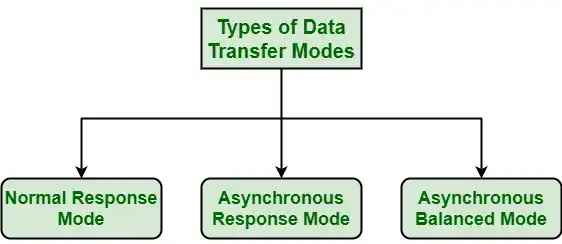HDLC: Meaning and Comprehensive Overview
Updated on : 09 June 2025

Image Source: google.com
Table Of Contents
- 1. Introduction
- 2. What is HDLC Definition and Purpose
- 3. Key Features of HDLC Protocol
- 4. HDLC Frame Structure
- 5. Types of HDLC Configurations
- 6. Modes of Operation in HDLC
- 7. Advantages of HDLC
- 8. Limitations of HDLC
- 9. HDLC vs. Other Data Link Protocols
- 10. Applications of HDLC in Modern Networking
- 11. Implementing HDLC in Software Systems
- 12. Challenges in HDLC Implementation
- 13. FAQs
Table Of Contents
Introduction
HDLC (High-Level Data Link Control) is a cornerstone protocol in data communication, enabling reliable and efficient data transfer over networks. It manages error detection, flow control, and data framing, making it essential for modern networking systems.
What is HDLC Definition and Purpose

Image Source: google
HDLC (High-Level Data Link Control) is a bit-oriented synchronous data link layer protocol developed by the International Organization for Standardization (ISO). Its primary purpose is to:
- Ensure Reliable Data Transfer 📡
- HDLC: Meaning and Comprehensive Overview provides error-free communication through error detection and retransmission mechanisms.
- Support Multiple Network Topologies 🌐
- Works in point-to-point and multipoint configurations.
- Facilitate Flow Control ⚙️
- Manages data flow to prevent overwhelming the receiver.
- Standardize Data Framing 📦
- HDLC: Meaning and Comprehensive Overview organizes data into structured frames for consistent transmission.
Key Features of HDLC Protocol
| 🔑 Feature | 📌 Description |
|---|---|
| Bit-Oriented | Processes data as a stream of bits, allowing flexibility with various data types. |
| Synchronous Transmission | Uses clock signals for synchronized data transfer, ensuring efficiency. |
| Error Detection | Employs CRC (Cyclic Redundancy Check) to detect transmission errors. |
| Flow Control | Manages data rate to prevent buffer overflow using sliding window mechanisms. |
| Full-Duplex Support | Enables simultaneous two-way communication for faster data exchange. |
| Flexible Configurations | Supports point-to-point and multipoint network setups. |
HDLC Frame Structure

Image Source: google
HDLC organizes data into frames, each containing
| 🧩 Frame Component | 📌 Description |
|---|---|
| Flag | Marks the start and end of a frame (01111110 binary sequence). |
| Address | Identifies the destination device in multipoint setups. |
| Control | Specifies frame type (information, supervisory, or unnumbered) and sequence numbers. |
| Data | Contains the actual payload or information being transmitted. |
| FCS (Frame Check Sequence) | Uses CRC for error detection. |
| Closing Flag | Signals the end of the frame, identical to the opening flag. |
Types of HDLC Configurations
| 🔄 Configuration | 📌 Description |
|---|---|
| Point-to-Point | Direct communication between two devices, ideal for dedicated links. |
| Multipoint | One primary device communicates with multiple secondary devices. |
| Loop | Devices are connected in a loop, with data passing through each node. |

Custom networking solutions, crafted with precision by Hexadecimal Software.
Modes of Operation in HDLC

Image Source: google
HDLC (High-Level Data Link Control) operates in three modes:
- Normal Response Mode (NRM)
- Primary station controls communication; secondary stations respond only when polled, ensuring structured data flow in HDLC: Meaning and Comprehensive Overview.
- Asynchronous Balanced Mode (ABM)
- All stations are equal, enabling peer-to-peer communication without a primary controller, a key feature of HDLC: Meaning and Comprehensive Overview.
- Asynchronous Response Mode (ARM)
- Secondary stations can initiate communication without polling, but a primary station still exists, enhancing flexibility in HDLC networks.
You Might Also Like
Advantages of HDLC
| ✅ Advantage | 📌 Description |
|---|---|
| Reliability | Ensures error-free data transfer with CRC and retransmission. |
| Efficiency | Synchronous transmission reduces overhead and speeds up communication. |
| Flexibility | Supports various network types and data formats. |
| Scalability | Works in both small and large network setups. |
| Full-Duplex Support | Allows simultaneous bidirectional communication. |
Limitations of HDLC
- Complexity 🛠️
- HDLC: Meaning and Comprehensive Overview requires sophisticated hardware/software for bit-level operations.
- Limited Error Correction 🚫
- Detects errors but relies on higher layers, increasing latency.
- Not Ideal for High-Latency Networks 🌍
- Synchronous HDLC: Meaning and Comprehensive Overview struggles with delays.
- Proprietary Variants 🔒
- Non-standard versions (e.g., Cisco’s) cause compatibility issues.
HDLC vs. Other Data Link Protocols

Image Source: google
| ⚖️ Protocol | 📌 Comparison with HDLC |
|---|---|
| PPP (Point-to-Point Protocol) | Simpler, used for direct connections, lacks HDLC’s multipoint support. |
| Frame Relay | Faster for WANs but less reliable; HDLC offers better error control. |
| Ethernet | Widely used in LANs, less suited for synchronous WANs compared to HDLC. |
| SDLC | IBM’s precursor to HDLC, less flexible and outdated. |
Applications of HDLC in Modern Networking
| 📋 Application | 🔍 Description |
|---|---|
| 📞 Telecommunications | Used in ISDN and frame relay networks for reliable data transfer with HDLC: Meaning and Comprehensive Overview. |
| 🛰️ Satellite Communication | Ensures accurate data transmission over long distances using HDLC: Meaning and Comprehensive Overview. |
| 🌐 WAN Connectivity | Powers point-to-point links in wide area networks. |
| 🖥️ Legacy Systems | Still used in older networking equipment and protocols like X.25. |
| ⚙️Embedded Systems | Employed in industrial control systems for reliable communication. |

Need robust networking solutions? Hexadecimal Software builds it to last.
Implementing HDLC in Software Systems
- Choose a Technology Stack
- Use C/C++ for low-level implementation or Python for prototyping.
- Frame Construction
- Develop logic to create and parse HDLC frames (flag, address, control, etc.).
- Error Detection
- Implement CRC-16 or CRC-32 for frame check sequence.
- Flow Control
- Use sliding window protocols to manage data flow.
- Testing
- Simulate network conditions to ensure reliability and performance.
- Integration
- Interface with hardware (e.g., modems) or higher-layer protocols.
Challenges in HDLC Implementation
| ⚠️ Challenge | 🔍 Description |
|---|---|
| 📌 Bit Stuffing Complexity | Avoiding the HDLC flag sequence (01111110) requires bit stuffing, which adds processing overhead. |
| 🧰 Hardware Dependency | Synchronous communication in HDLC requires accurate clocking and specialized hardware. |
| 🔗 Interoperability Issues | Vendor-specific HDLC implementations (e.g., Cisco HDLC) may create compatibility problems. |
| 🌐 Scalability for Large Networks | Managing multipoint configurations with many nodes increases resource and configuration complexity. |
| 🛠️ Debugging and Testing | Identifying and resolving bit-level transmission errors in real-time systems is technically challenging. |
FAQs
Q.1. What does HDLC stand for?
A: HDLC stands for High-Level Data Link Control, a protocol for reliable data transfer in networks.
Q.2. What is the main purpose of HDLC?
A: It ensures error-free data transmission, flow control, and proper framing in point-to-point and multipoint networks.
Q.3. How does HDLC detect errors?
A: It uses Cyclic Redundancy Check (CRC) in the Frame Check Sequence (FCS) to detect transmission errors.
Q.4. What are the types of HDLC frames?
A: HDLC frames include Information (I-frames), Supervisory (S-frames), and Unnumbered (U-frames).
Q.5. Is HDLC still used today?
A: Yes, HDLC is used in telecommunications, satellite systems, and legacy WANs, though newer protocols are more common in modern LANs.






